Embedded pharmacy in residential aged care has been successful in South Australia at the Tanunda Lutheran Home in the Barossa Valley. Julian Soriano talks about his pharmacy role in medication management and medication safety to deliver the best clinical care for residents.
After nearly 18 months, the role under Country SA Public Health Network run as a joint project embedding pharmacy into residential aged care with PSA, recently turned into a full time role for Julian at Tanunda Lutheran Home.
In this segment, Julian talks about the traditional pharmacy model serving residential aged care and the limitations of the imprest process for dispensing medication. Soon into the project he saw the collaboration required with GPs and onsite nurses in dispensing medication for residents in end-of-life or palliative care. Julian sees the imprest process unable to support end-of-life residents, even being able to check the availability of medication.
He sees the traditional model with pharmacy outside the aged care setting as quite rigid and pharmacists skills not fully utilised. The embedded model is able to deliver improved quality use of medicine for the nursing home and residents. This includes also education and building rapport with other health staff, residents and their families. Julian talks about a number of other key benefits such as improvement in the Residual Medication Management Review (RMMR) when a resident is in palliative care. This especially helpful for families, when the pharmacist, GP and nursing staff are able to talk with a resident’s family collectively.



